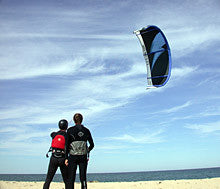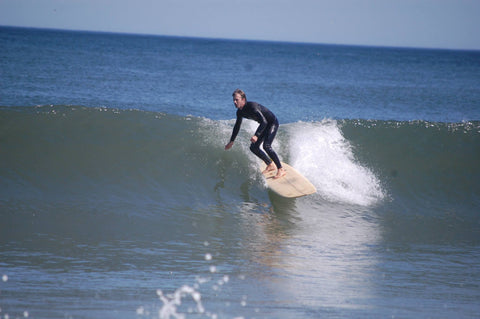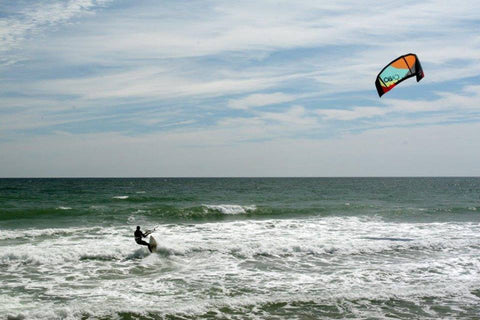
Blissful Boarding
Kiteboarding offers new kind of exhilaration for water sport enthusiasts
By Pru Sowers
Outer Cape Living
Summer 2005
Cathleen Creedon is being dragged through the frigid waters of Duck Harbor in Wellfleet. Four nylon cords tie her to a 20-foot-long kite straining high over her head. The wind is fierce. A two-way radio strapped to her shoulder crackles with instructions But there is nothing she can do except hang on and yank at the cords, trying to control the dancing parachute-like kite above her.
This is sport. Perhaps a bit extreme, but nonetheless a growing sport on Cape Cod, where the winds rarely stop blowing and sailors, windsurfers and now kiteboarders are in pig heaven. Kiteboarding is similar to windsurfing except that it uses a huge kite, instead of a sail mounted on a board, to capture the wind. The kiteboard is also shorter and lighter than a windsurfing board.
Kiteboarders are passionate about the sport, which has overtaken windsurfing in places like Wellfleet and West Dennis. In addition to the lighter and less bulky equipment, kiteboarders liken the blissful sensation they feel while kiting to that of flying.
At this moment, though, Creedon doesn't feel blissful. An avid windsurfer for years. Creedon had been craving a new challenge, one that didn't require winds of 20-plus knots to get going fast enough to fulfill her addiction to wind and speed, kiting only takes about 10 knots to generate enough power for the kite to pull you along. Once you're good at it, you can essentially water-ski behind the Cape Cod winds, jumping waves and leaving a wake behind you.
But getting that good requires a pretty big commitment.
"You have to get to the point where you're flying the kite and it's not flying you," says Eric Gustafson, Creedon's kiteboarding instructor. "Cathleen is having a little trouble with that."
Gustafson is the owner of Fun Seekers (www.funseekers.org), a Wellfleet-based operation winch offers instruction and guided tours for kiteboarding, windsurfing, surfing and kayaking. He has taught kiteboarding on the Cape for the past five years and watched as it slowly caught on. One of the reasons kiteboarding and windsurfing have become popular Cape sports is because both the ocean and bay beaches curve in almost a 360-degree arch, Gustafson says.
"The nice thing about the Cape is there's a great place for every wind direction," he say. "If it's not blowing the way you want on one beach, yon just go to the next one."
Gustafson is so enamored of the sport that he teaches kiteboarding on the open, snow-packed hills in Utah during the winter. But right now, he is watching as Creedon tries to get her board under her and use the power of the wind-filled kite to pull her out of the water.
"Keep your ankles together," Gustafson says into the two-way radio, watching Creedon struggle as the kite pulls her back and forth through 52 degree water. "That's it. Excellent."
Before Creedon hit the water, Gustafson instructed her on the beach about how to control the huge kite. Her wetsuit-booted feet skidded in the sand as she tried to make the kite perform controlled movements.
The kite itself, neon green, weighs practically nothing, its nylon ribs inflated with air like an air mattress to give it enough rigidity to grab and hold the wind.
"Keep your arms away. Stop it there. Good" he told her on the beach as Creedon began to get the hang of pulling on the lines to move the kite back and forth.
"So now what?" she asked him, as she gained some control.
"Fly it!"
The principal is the same as you learned as a kid. A control bar uses nylon cords to open and close the kite. But the equipment has changed a bit for this sport. A new kite costs between $800 and $1,400. The board costs around $700. And it's not something you can teach yourself.
"The goal is to move perpendicular to the wind and return to point A. Doing that takes quite some time. It takes about two three-hour lessons to get up," Gustafson says.
But when you do - heaven on water!
"It's exhilarating. Anytime when Mother Nature is pulling you along is great," Gustafson says, adding that it's easy to get hooked on kiteboarding. "You start looking at flags and treetops to see if the wind is blowing."
Creedon watches the trees. And when she sees that it's blowing, she heads to the beach, either to windsurf or now, kiteboard. Her employer. Cape Cod Healthcare, is used to her unusual requests for vacation time. She takes a half day here, two hours there - anything to get to the water when the wind is blowing hard.
But right now, she's not thinking about work. She's thinking about how to leverage her neoprene-clad body out of the Atlantic Ocean so she can ride on top of it. She struggles in the water, trying to get her feet and board underneath her.
"Watch," says Gustatson. "Here she goes."
Creedon pulls herself into an upright ball, almost in the fetal position. She adjusts the cords connected to the kite soaring 50 feet over her head. Suddenly, with no warning, she is out of the water, her hands gripping the kite bar, her board streaming a whitewater wake behind her. She is up, heading for Plymouth at what likely seems to her to be the speed of light.
Then, just as suddenly, she is back in the water, unable to sustain the movement. She tries again and again, then tires and heads back to the beach.
"When you fall off a windsurfing board, everything stops," she says. "When you crash at kiting, it's just beginning You're getting dragged through the water. Nothing stops."
"But when I do get up, I'm so psyched. It's a very weightless feeling, a feeling of flying, with the exhilaration of speed. It's spiritual. What it does for your mindset, I can't even describe," she says.
Two days later, Gustafson is back on Duck Harbor beach with some new students. About 10 locals also are out with their kites. And Creedon is there, too.
"I've got to hang with it, pay my dues I know what I need to work on, which is half the battle," she says, adding, "My goal is that I am going to master kiting this summer."


